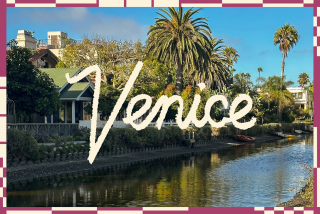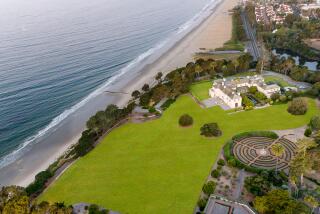The Lure of the Luxurious Lakes
A 10-piece band with a harp and an accordion cranked out a mambo from a stage in the overflowing plaza. A tall man with blue-black hair beckoned my wife over to a long table.
“Vino rosso?” he asked, and he poured Bobbie two glasses of a robust red wine. Four hundred people filled the square, eating free bread, cheese and salami and drinking glass upon glass of wine. It was a festival, we later learned, in honor of the Piedmont truffle, another excuse for a party in a land of eternal celebration.
We were in the heart of the Italian Lakes District, a magnet for more than 150 years for the rich, royal and romantic. The English poets William Wordsworth and Lord Byron loved the Lakes District. Vincenzo Bellini composed the opera “Norma” at his villa on the shore of Lake Como, and Giuseppe Verdi composed “La Traviata” at his villa nearby. Umberto Giordano wrote “Fedora,” an opera featuring bicycles onstage, in Baveno.
All were drawn to the Lakes District for the same reason: its beauty. Depending on the light and the time of day, the lakes can be emerald, turquoise or sapphire. Gouged out by glaciers rolling down from the Swiss Alps during the Pleistocene era, the last ice age, they owe their color to their extraordinary depth and the reflections of the mountains that surround them. Of the seven lakes, all in northern Italy near the Swiss border, Garda is the biggest--29 miles long, 10 miles wide--and Como, at 1,345 feet, is the deepest lake in Europe.
Five years ago, when the dollar bought only 1,460 Italian lire, we could not have afforded to stay here. Last summer, with the lira down 33%, we were finding bargain after bargain. Most rooms in Bellagio on Lake Como, for instance, were now cheaper than those in that other Bellagio in Las Vegas. There were no dancing water displays at the Italian Bellagio, but there were spreading cypress trees, lush green mountains, silver sailboats, salmon-colored villas and, best of all, cheap ties.
No place in the Lakes District was cheaper than Baveno, a bucolic village, population 4,400, lined with pink oleander bushes and filled with red azalea blossoms and purple and blue hydrangeas. A 25-minute ferry ride from the hot action in Stresa on Lake Maggiore, an hour’s drive west from the glamour of Como and the glitz of Bellagio, laid-back Baveno on Lake Maggiore had to give away the store to compete.
The town is built in two tiers, lakeside and hillside. The lakeside level winds past parks, villas, a castle, cafes, gelaterie and an outdoor market, centered on a piazza that faces the boat landing. The castle, Castello Brance, was Queen Victoria’s headquarters in the summer of 1879. Her attendants lodged next door at the Lido Palace, where we stayed.
The hillside tier, dense with lush greenery, is the heart of the backpackers’ Baveno, built around the 11th century Church of Santi Gervasio e Protasio and a tiny train station that looks like a toy. The church’s little octagonal 5th century baptistery is a jewel. Nearby, drying laundry flutters in lake breezes, and girls on bicycles carry loaves of bread under their arms.
Our room at the Lido Palace overlooking Lake Maggiore cost $130 a night in August, in the middle of high season, and dropped to $87 this month. In the autumn of 1908, Winston Churchill spent his honeymoon at the Lido in Room 124, and Ray Charles stayed here for three nights last year. Built as a villa in 1857 for the Marquis Durazzo of Genoa, the Lido has ornate white marble carvings over each doorway, 22-foot ceilings, antique furnishings and walls of etched glass. A statue of Queen Victoria towers over a formal garden. In a lounge, for four hours every evening, a Romanian pianist and violinist play music from a vanished world.
As guests, we were treated like royalty. We had only to approach the front desk to receive our room key without a word; the staff knew our room number. The staff was so charming that Jack Teal, a hotel guest from Newport Beach, peppered them with questions just to hear them talk.
Teal was on our group tour, our first in 30 years of travel. For years, Bobbie had been complaining that traveling with me--jumping off moving trains and eating in hellish dives--was too much work. “Why couldn’t we just plop ourselves down in air-conditioned buses like normal people?” she asked.
To appease her, when we received a flier from UCLA Alumni Travel listing a week’s tour of the Lakes District for $2,445 per person, including air fare, accommodations and all meals, I sent in a deposit immediately.
I had fears of regimented days and distasteful companions. I was wrong on both counts. Because we spent the entire week at one hotel and never had to make a connection, we were free to skip any group activity and go off for romantic outings of our own.
We liked most of the tour’s 42 other members and found much in common with many. After a few meals together and endless wine at lunch and dinner, we began to bond, like kids at camp. We giggled over the fish heads on our plates and the antics of the more eccentric members of our group.
Most were married couples, ranging from mid-40s to mid-90s, and professionals. Nearly everyone was well traveled. Although this was a UCLA Alumni Assn. tour, many of us--including Bobbie and me--were not UCLA alums.
Everything ran like clockwork. For me, though, there was something lost in having no opportunity to miss trains, to lose our way, to need help at a pay phone or the Laundromat: contact with the locals. We did not get to know anyone who was not in the tourist trade.
Those we did meet were warm and welcoming. Each morning, the hotel’s owner, Pietro Paolo d’Amico, who always wore a yellow suit, greeted each of us with a hearty “Buon giorno” and poured us what he called “my delicious coffee.”
One night, choosing to skip the prepaid meal at the Lido, I asked Pietro’s son and the hotel’s manager, Paolo, to send us to the best restaurant in Baveno, and hang the expense. His recommendation, Posta, was a family-friendly ristorante that was packed with kids playing “rock, paper, scissors” and--as is customary in Italy--drinking red wine.
Bobbie and I shared rigatoni filled with ground veal, ravioli in tomato sauce, breaded veal cutlet, grilled lake trout, lemon gelato and crème caramel, plus French fries and breadsticks, and we drank a half-liter of Barbera wine. It was a hearty feast, all for $27.
The next night, we sought a more adult-oriented place. Baveno’s ferry landing was just a few minutes away, and from there we could sail to glamorous Stresa, to the gardens of Isola Madre, to the Borromeo palace at Isola Bella or to the languorous fishing village of Isola Pescatori.
During the day, a ferry ride costs $1.30 each way, but at night it’s free, so we boarded at twilight for a big-splurge dinner two miles south at Stresa on Lake Maggiore. In Stresa we wandered along the broad lakefront promenade, built by Napoleon and lined with cedars, and through narrow cobblestone streets. At a sidewalk cafe called Lo Stornello, a waiter in a black vest seated us under a green and coral umbrella. Only a delicate white wrought-iron railing separated us from the passing high-fashion parade. I ordered risotto Milanese, a regional specialty, simmered with saffron to a bright yellow, and Bobbie had curried penne pasta with baby shrimp and tiny peas. We split veal pizzaiola, with zucchini and parsleyed potatoes and lots of oregano. The food was a marvel and the setting, breathtakingly romantic. Our bill came to $39.
One day our group boarded a bus for a day at Lake Como. Between a tour of the monumental gardens and art treasures at Villa Carlotta on the lake’s western shore and lunch on the terrace at Hotel Suisse in Bellagio, Bobbie and I found time for shopping. At Ad Hoc, on Bellagio’s lakefront, we found hundreds of silk ties with bold patterns in bright colors for $11.
“Bellagio is the world capital of ties,” the clerk told us.
Later that day, at the southern end of the lake in Como, a quintessential Italian town filled with Romanesque monuments and wedding-cake hotels, we found some of the same ties for $7 at Tabacchi, a store on Piazza Cavour.
The biggest shopping bargain of all, though, was back in Baveno. Off the lobby of the best hotel in town, the Grand Hotel Dino, we found copies of Rembrandts, Monets, Gauguins and Modiglianis for $900 to $4,500. There were about 40 of them, art’s greatest hits as painted by Sergio Putatti.
Drinks, too, were a good deal in Baveno. At a kiosk in Villa Fedora Park, an espresso cost 65 cents, a glass of white wine 85 cents, and a glass of Campari $1.30. Sipping drinks at a nearby cafe called Miralago, we watched life unfold across the street at the stalls of the outdoor market, where vendors sold wine that you could sample in plastic cups and olive oil that you taste by sopping it up with croutons. A butcher sold slices of pork that he trimmed deftly off a whole pig, and a candy seller weighed out marzipan and three kinds of nut brittle for 70 cents a pound. A woman sold crepes in 12 flavors, including hazelnut, vanilla pudding and artichoke.
Pastry and puddings were superb, particularly rum cream cake and, above all, tiramisu. The pastry chef at the Lido Palace, in particular, was a genius, especially with his meringata, a confection made of meringue.
And the gelato! The gelato in this part of Italy has a searingly intense flavor. Bobbie’s favorite, served at Miralago, our favorite sidewalk cafe in Baveno, was the coppa con frutta: a 5-inch-high vanilla gelato piled with raspberries, blackberries and chunks of cantaloupe, kiwi, pineapple and peach, with chocolate chips and whipped cream, for $5.
After the last lira had been counted, the greatest pleasures of the Lakes District, we found, cost little or nothing: the gorgeous gardens at Villa Carlotta in Tremezzo on Lake Como or at Villa Taranto in Verbania on Lake Maggiore; the crazy quilt of a monastery that crowns the Isola San Giulio in Lake Orta; the scent of olive oil and lemons in the air or the sight of a grin on the face of a stranger giving you a gift of wine.
Barry Zwick is a Times news editor.
More to Read
Sign up for The Wild
We’ll help you find the best places to hike, bike and run, as well as the perfect silent spots for meditation and yoga.
You may occasionally receive promotional content from the Los Angeles Times.






